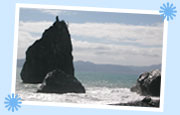Sightseeing
• Nature Areas & Beaches • |
Nature Areas and Beaches
Ampere Beach
Getting There: From Baler town proper, take a tricycle going to Sabang Beach. From there, hire a motorized banca and ask to be taken to the site.
Travel Time: One hour
This beach is covered with smooth rocks of various sizes and darker color. This beach is an area called Bunga Point or Ampere Point, where local residents flock to Okotan Cave, a time-honored locale for forecasting the weather. The Pacific waves, upon hitting the shoreline cave, produce an explosion, the intensity of which, according to local lore, determines the intensity of the incoming weather.
Aniao Islets
Location: Off the coast of Barangay Zabali, Baler
Getting There: Take a tricycle from Baler town proper to the river outlet south of Sabang Beach. From there, hire a motorized banca which can take you to the area.
Travel Time: Five minutes by tricycle and 20 minutes by boat
Two small but imposing islands lie south of the islet of Dimadimalangat. These islets jut straight from the sea like bullets, with shrubs, small trees and other greenery growing on top surfaces. Kingfishers, gulls and hawks use these islets as lookout points for fish. Towering waves relentlessly pound the base of the formations, challenging even the most intrepid of rock climbers.
Balete Park & Millennium Tree
This park contains a 600-year-old balete tree that was designated the official "Millennium Tree" of The Philippines. It is the largest tree of its kind in Asia, and it would take 60 grown men, holding one another at arm's length, to encircle its gigantic trunk.
Due to its age, the tree's thick roots have grown above ground, such that caves have formed under various sections of the trunk. This unique tree has generated national media attention and is now the most visited tourist spot in Aurora.
Banju Springs
Location: Barangay Real, San Luis
Getting There:Take a private vehicle or hire a jeep from Baler town proper to Barangay Real in San Luis. Another kilometer-and-a-half walk on a rough road passing through a rice field will take you to this site.
Travel Time: Approximately an hour's drive
Natural terraced steps overflowing with spring water best describe the Banyu Springs. A mass of ferns surrounds the springs, which stretch up to a hundred meters toward the source of the spring, hidden amidst shrubbery. Because a cement quarry located under the spring flow was exposed and weathered due to the constant flow of water, the cement settled into a terraced formation.
Borlongan Beach
Location: Barangay Borlongan, Dipaculao
Getting There: From Baler town proper, take a tricycle going to Sabang Beach. From there, hire a motorized banca that can take you to the site.
Travel Time: About two hours
Borlongan Beach, like Ampere Beach, is covered for several kilometers with gray pebbles and smooth, fist-size stones. This makes Borlongan beachfront different from most other beaches.
Casiguran Sound
Getting There: Hire a motorized banca from Baler town proper and head north.
Travel Time: Approximately 5.5 hoursCasiguran Sound is a bay nearly enclosed by the Casiguran landmass and the cape of San Ildefonso. Only a kilometer-wide inlet serves to connect the sound to the sea. Its very location provides protection from the typhoons that seasonally ravage most of the province. Casiguran Sound is also unaffected by the monsoon winds that blow from October through February, making it an ideal spot for windsurfing, should facilities be available. For the time being, bring your own windsurfing equipment.
The area has its share of white beaches and numerous places for relaxation. Many foreigners have taken advantage of the natural placidity, having built vacation homes along the coast.
Cemento Beach & Reef
Location: Barangay Cemento, Baler
Getting There: Take a tricycle from Baler town proper to the river outlet south of Sabang Beach. From there, you can either hire a motorized banca for a 10-minute ride to the reef, or take a 40-minute walk.
White sand, seashells, and crushed corals carpet the stretch of Cemento Beach. From October to February, waves tower up to 14 feet high, making for excellent and challenging surfing, as experts from Europe, Japan and Australia can attest. The area is recommended for expert or professional surfers as the waves break at the reef and are of the right-hand break type. The surfer is advised to wear wetsuits for protection.
The area is also suitable for snorkeling and wall diving during the calm season from April to June. Finally, Cemento Beach is a popular haven for lobsters and other marine species.








